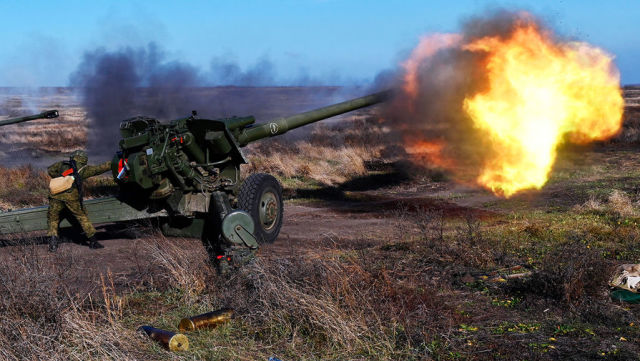VNII "Signal" proposed to modernize the artillery from obsolete guns
In Russia, it was proposed to create a "smart" artillery from obsolete guns. For this purpose, the Signal Research Institute plans to develop a set of unified equipment that will provide automatic data entry for firing on towed guns. In turn, this will allow them to be upgraded to the level of highly effective artillery systems. Military observer " of the Newspaper.En " Mikhail Khodarenok dealt with the company's initiatives.
The Missile Forces and artillery of the Russian Armed Forces, along with self-propelled artillery installations, have a number of towed guns, the data for firing in which are entered manually. Also-in manual mode-aiming at the target and fire is carried out.
At the same time, the requirements of modern combat operations imply an increasingly high degree of automation of weapons of destruction within a single reconnaissance and strike system. In particular, for artillery, it is supposed to automatically receive information about enemy targets and their coordinates via communication channels, automatic guidance and calculation of the moment of opening fire.
Due to manual control, non-self-propelled howitzers are deprived of the possibility of full integration into a single information field in real time. It is these shortcomings that are proposed to be eliminated in the Signal Research Institute (part of the" High-precision Complexes "of the Rostec State Corporation), creating so-called" smart "artillery from outdated guns, RIA Novosti reports.
In service with this type of troops from towed guns today is mainly 152-mm gun 2A65 "Msta-B". One could also call the light 152-mm howitzer 2A61 "Pat-B", which has a mechanized shell loading and a variable recoil length. But this weapon is released only in a few copies.
The firing range of the 2F65 high-explosive projectile of the 2A65 Msta-B cannon is about 24 km, and the active-jet projectile is 28.9 km. The rate of fire of the gun is seven rounds per minute. In total, these guns were produced by the domestic industry about 1,200 units.
Somewhere in the bases of storage of weapons and equipment (arsenals), there are probably even more rare examples of towed artillery (such as the 122-mm howitzer D-30 or 152-mm howitzer D-20), but, most likely, they are unlikely to be used in a hypothetical armed confrontation with a high-tech enemy.
It should be noted that back in the early 1990s, the NATO member countries adopted the "Joint Memorandum on Ballistics". The optimal type in the North Atlantic Alliance was recognized as a 155-mm howitzer with a barrel length of 52 calibers (that is, in fact, a howitzer-gun) and a charging chamber volume of 23 liters instead of the previously accepted 39 calibers and 18 liters. The new standard set the maximum firing range of these guns with high-explosive shells at 30 km, and active-reactive shells at 40 km.
Even if you upgrade all the 152-mm 2A65 Msta-B guns available in the RV and A, they still do not reach the NATO standards in terms of firing range. And in modern combat, as you know, the winner is the one who saw the enemy earlier, at night they fight like day and, most importantly, they shoot further.
For comparison, the German self-propelled artillery PzH 2000 (Panzerhaubitze 2000) has a range of 30-50 km. The howitzer holds the world record - at the test site in South Africa, it fired a V-LAP projectile (an active-jet projectile with improved aerodynamics) at 56 km. In Afghanistan, PzH 2000 has been dubbed the "long arm of the International Security Assistance Force". According to the totality of indicators, the PzH 2000 is considered the most advanced serial self-propelled gun in the world.
We can say that it is not quite correct to compare a towed and self-propelled howitzer. But in this case, it is not the speed of changing the firing position that is compared, but only the firing range.
For example, the experimental 155-mm towed howitzer M777ER developed by BAE Systems with an elongated barrel of 52 caliber, which is planned to be adopted for equipping the artillery of the US Army, has a firing range of up to 70 km. The howitzer's ammunition will be active-the XM1113 rocket projectile and the XM654 charge, the automatic loader and the new fire control system.
A 152-mm self-propelled howitzer of the brigade level 2S35 "Coalition-SV"has a similar firing range in the RV and A of the Armed Forces of the Russian Federation. The 2S35 self-propelled gun is designed to destroy tactical nuclear weapons, artillery and mortar batteries, tanks and other armored vehicles, anti-tank weapons, manpower, air defense and missile defense systems, control points, as well as to destroy field fortifications and hinder the maneuvers of enemy reserves in the depth of its defense.
It is for these reasons that in recent years almost all samples of towed artillery in the West and East are gradually changing to self-propelled installations. Towed artillery in modern military conflicts is used mainly against irregular formations.
In the conditions of mountain warfare, self-propelled artillery installations in most cases can not be used at all. In addition, the self-propelled gun is significantly more expensive than the towed gun. Therefore, despite the low maneuverability, towed guns are still in service with the artillery of most countries of the world.
In this regard, it is enough to name 155-mm howitzers KN179 (South Korea), FH-77B (Sweden), G5 Mk3 (South Africa), GH (Finland), TIG 2000 (Israel) and GH N (Austria, Belgium, Canada).
On the one hand, the automation proposed by the Signal Research Institute will reduce the cycle of combat control of non-self-propelled artillery several times, as well as ensure its integration into the automated command and control system and, in the future, into a single reconnaissance and strike system. On the other hand, if domestic guns are inferior to the artillery of a hypothetical enemy in terms of firing range, then it will be very difficult to fully realize these advantages on the battlefield.
Mikhail Khodarenok

